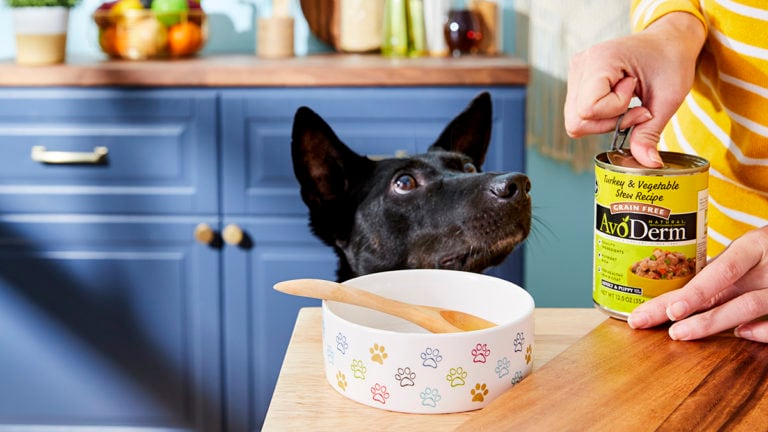If you’re a pet parent who’s dealt with dog food allergies, the following story might sound all too familiar:
“I have a 1-year-old Staffordshire Terrier named Kiki who I adopted about four months ago. Right away she had an ear infection, and our veterinarian prescribed antibiotics. She got better but developed two more ear infections in the next couple of months.
At first, I thought Kiki was just prone to ear infections. But then she started getting flaky skin and some scabs that recently have gotten a lot worse. Kiki scratches and bites at her skin until it bleeds. She’s on a good flea control medicine, so I don’t think that’s the problem. I’ve tried giving her baths with an oatmeal shampoo and switched her to a grain-free dog food, but nothing has helped.”
That is an edited version of a message I received from a very worried parent awhile back. The symptoms Kiki exhibited were classic signs of dog food allergies.
Dog Food Allergy Symptoms
At this point you might be thinking, “Food allergy? Doesn’t that cause stomach problems?” The answer is “sometimes,” but dogs with food allergies more typically experience some combination of the following symptoms:
- Chronic itchiness
- Skin lesions caused by self-trauma or infection
- Recurrent ear infections
- Gastrointestinal upset (in rare cases)
All of these symptoms should remain fairly consistent (regardless of changing seasons, for example) as long as the dog’s diet does not change.
Diagnosing Dog Food Skin Allergies
Unfortunately, the symptoms associated with dog food skin allergies also are seen with a very long list of other canine health problems. When faced with a dog like Kiki, veterinarians typically start the diagnostic process with a complete history, physical examination and some diagnostic tests and/or treatments to rule out conditions like fleas, bacterial and yeast infections, mange, ringworm and allergies to environmental triggers, like pollen and mold.
Only then will most veterinarians turn to the possibility of food allergies. Why? Because food allergies are rare, and the diagnostic process involves a lengthy and inconvenient food trial. Blood tests and skin “patch” tests are available, but they do not generally produce reliable results.
Appropriate Diets for Food Trials
Prescription diets that are made from novel or hydrolyzed proteins are appropriate for food trials. Novel proteins come from ingredients that a dog has never been exposed to before.
For example, Royal Canin Veterinary Diet Selected Protein Adult PR Dry Dog Food is made with rabbit meal, while Hill's Prescription Diet d/d Skin/Food Sensitivities Duck Formula Canned Dog Food contains duck. Novel proteins work because it takes prior exposure to an allergen for an allergic reaction to develop. Therefore, you must be 100-percent sure that your dog’s previous diets did not include any of the novel protein sources in the diet you plan to use for a food trial.
Hydrolyzed proteins can come from almost any source but are broken down into such tiny fragments that the immune system no longer reacts to them. Hill's Prescription Diet z/d Original Skin/Food Sensitivities Dry Dog Food contains hydrolyzed chicken liver, while Royal Canin Veterinary Diet Hydrolyzed Protein Adult HP Canned Food is made from hydrolyzed chicken liver and hydrolyzed soy protein.
These types of diets also typically include relatively hypoallergenic or novel carbohydrate sources.
Prescription dog foods for dogs with allergies are superior to over-the-counter options because the former comply with strict quality control measures that virtually eliminate the chance that they will contain (or be cross-contaminated with) ingredients other than those described on the label. Homemade diets also can be used during a food trial, but they should be designed by a veterinary nutritionist to be complete and balanced.
A hydrolyzed diet called Royal Canin Veterinary Diet Ultamino Dry Food is unique. Its protein source is feather meal, which is literally poultry feathers that have been hydrolyzed down to “an amino acid level.” It also uses corn starch (from which most of the potentially allergenic protein has been removed) as a carbohydrate source. All of these characteristics—as crazy as they may sound—are sometimes necessary to diagnose and manage dogs with severe dog food allergies. In fact, my own dog’s food allergy-related inflammatory bowel disease is best managed with Purina Pro Plan Veterinary Diets HA Hydrolyzed Formula Dry Dog Food, which is made from corn starch and hydrolyzed soy protein isolate.
How to Perform a Food Trial
Whichever diet is used during a food trial, it must be fed for 8-12 weeks to fully assess the dog’s response. During this time, your dog can drink only water and eat the novel or hydrolyzed protein diet, avoiding all other foods, treats and even flavored medications. Dogs with food allergies should experience a significant reduction in their symptoms during this time as long as they are not allowed to “cheat” and the food used in the trial was appropriate.
Once a food allergy has been diagnosed, some veterinarians recommend a dietary challenge with the dog’s original diet to confirm the diagnosis. When food-allergic dogs eat their old diets, their symptoms should return within two weeks or so and then resolve once they are put back on the novel or hydrolyzed protein diet used during the food trial.
At this point, you can try to identify your dog’s exact triggers so they can be avoided in the future. A recent study found that in dogs with food allergies, the most common allergens were:
- Beef (34%)
- Dairy products (17%)
- Chicken (15%)
- Wheat (13%)
- Soy (6%)
- Lamb (5%)
- Corn or egg (4% each)
- Pork, fish or rice (2% each)
- Barley, rabbit, kidney bean and tomato were food allergens for single dogs
How to Treat Dog Food Allergies
In comparison to diagnosing dog food allergies, treatment is relatively straightforward. Dogs should never eat their triggering ingredients. In other words, if Kiki was diagnosed with allergies to beef, chicken and wheat (yes, multiple food allergies are common), then she should never eat beef, chicken or wheat.
In dogs with multiple, severe food allergies, this may be accomplished best by continuing to feed them the prescription novel protein or hydrolyzed protein dog food for dogs with allergies that was used during their trial. Milder cases may respond adequately to appropriate over-the-counter dog foods, limited ingredient diets or grain-free dog foods (assuming the dog is allergic to one or more grains). But remember that flare-ups are possible if these diets are contaminated with ingredients not listed on the label. Talk to your veterinarian to determine the best dietary options for your dog.
At the end of the day, food allergies cannot be cured, but they can be managed successfully with the right dog food for dogs with allergies.
Share:














